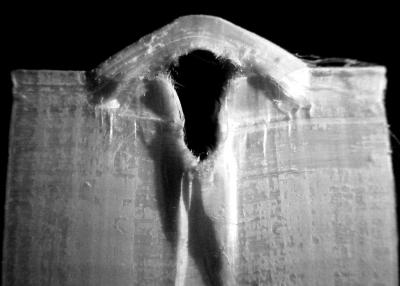Scientists from Aarhus University and the University of Cambridge are first to measure and set guidelines for bolted joints using the up-coming replacement for Kevlar: the ultra-strong material with the catchy name ultra-high molecular weight polyethylene

Credit: Simon Skovsgård
Imagine a velvety, soft material that is extremely light, but also strong enough to stop a bullet. This is close to a description of ultra-high molecular weight polyethylene (UHMWPE), a super-plastic material commercially known as Dyneema or Spectra, which is already taking over from the para-aramid fibrous material, Kevlar, in e.g. bullet-proof jackets.
There is also much need for the super material in many other applications than body armour, and therefore researchers have now set up guidelines and failure maps for use of the material in joints with steel bolts. The research team is being led by Simon Skovsgård, PhD and MSc in engineering at the Department of Engineering, Aarhus University, and Professor Norman Fleck at the University of Cambridge.
The results have just been published in the International Journal of Solids and Structures.
“The tests we’ve done showed that the material began to deform at the joints, but the fibres weren’t broken. This is interesting in relation to other popular composite materials, such as carbon fibre composites, which snaps suddenly. Here, although we can tear the material, it’s really difficult to actually break the fibres,” says Simon Skovsgård.
UHMWPE consists of extremely long chains of polyethylene (PE). And these long chains strengthen the intermolecular interactions of the substance and enable the material to transfer stress loads effectively to the polymer skeleton.
This means that UHMWPE fibres has an incredibly high tensile strength compared to many other thermoplastics, and this also means that the material is much stronger than steel in the fibre direction. The tensile strength of high-strength steel is approx. 900 MPa, but in order to break the fibres in UHMWPE, you need approximately 3000 MPa.
“UHMWPE fibre plates are a collection of these incredibly strong fibres. It’s almost impossible to extend and break the fibres, but if you twist or shear the material, it is soft. This combination makes it easy for the material to absorb energy,” says Simon Skovsgård.
The new research results are good news for the commercial use of UHMWPE, which is increasingly being introduced in the shipping industry in containers, ropes and nets, as well as armour for vehicles and personnel and in the textile industry. So far, there has been no experience with using the material combined with other materials.
###
Media Contact
Simon Skovsgård
[email protected]
Original Source
http://eng.
Related Journal Article
http://dx.




